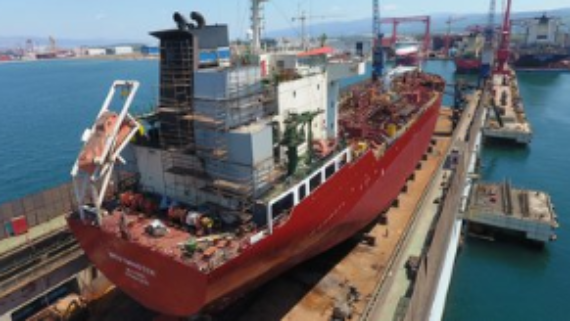Scrubber Technology
 ENVI-MARINE™
ENVI-MARINE™


 ENVI-MARINE™
ENVI-MARINE™
Scrubber Technology


Maritech Group is the exclusive authorized sales office for Greece.
Contact Us for more information about ENVI-MARINE™.
The ENVI-Marine™ process is a simple concept. First, it quenches the flue gases, then cleanses them by specialized frothing through pure seawater using the Patented TurboHead™ process. Next, it polishes and releases them as harmless salts. ENVI-Marine™ is fully flexible and can be designed as an open loop, open loop – closed ready or fully closed system. For vessels running HFO this system we offer industry-leading ROI and guaranteed compliance with enforced and future international emission standards.
Patented Turbohead
The foaming TurboHead™ provides a high-contact interaction zone between the exhaust gas and the neutralizing reagent. In the turbulent zone, 100% of the gas is exposed to continuous contact with the reagent. There are three turbulent scrubbing heads in the scrubber vessel, approximately 2m above each other, equipped with a set of spray nozzles to provide them with fresh seawater or recirculated scrubbing wash water. The scrubber water from the higher-level heads will drain down to the lower heads, so each head has a unique design to accommodate different water-volumes.
After passing through the three heads, the exhaust gas will enter the mist eliminator section and then exit out the stack to the atmosphere. The demister section is equipped with water spray nozzles to periodically wash away accumulated solids and prevent scaling.
In open-loop mode, raw seawater is pumped through the scrubber system counter-flow to the exhaust gas to absorb the SO2 and neutralize it with the seawater’s natural alkalinity. The exhaust gas leaving the scrubber is analyzed for SO2 and CO2 by the continuous emission monitoring system (CEMS) to ensure that the scrubbing efficiency meets the regulatory requirements. The rate of seawater flow to the scrubber heads is controlled based on the exhaust gas flow, the scrubbing efficiency and the pH of the effluent.
The wash water is analyzed for turbidity, pH and oil content (as PAH) on a continuous basis prior to being combined with reaction seawater and discharged.The reaction water may be sourced solely from engine cooling heat exchanger water with some modification to the overboard discharge piping. The reaction water increases the pH of the combined stream before discharge, and the pH is also monitored at that point to ensure the discharge meets the effluent quality requirements.
In closed-loop mode, seawater is recirculated through the scrubber with no discharge at sea. Losses of water to stack humidity and effluent storage are made up with fresh water or sea water, depending on the planned duration of closed mode operation. To clean the wash water for recirculation, a side stream of wash water is pumped through two hydrocyclone systems, one to remove soot and oil contaminants and the other to remove heavier ash solids.
Approximately 2L of oily sludge and 0.5L of ash sludge are generated for each tone of HFO fuel combusted. These sludges are stored in 1 m3 IBC totes for later disposal onshore.
Heat transferred from the exhaust gas to the wash water is removed using a heat exchanger in the recirculation loop. A seawater pump provides the heat exchanger with cooling seawater that is then discharged with other engine cooling seawater.
This pump may also be used in open-loop mode to provide reaction seawater. Caustic is added to the recirculating wash water to maintain the required alkalinity as measured by pH meters. Total dissolved solids are controlled by bleeding 1.0-1.5 m3 of wash water to an effluent holding tank per ton of HFO combusted. Once the scrubber returns to open mode operation, the stored effluent is returned to the recirculation tank for discharge along with the open-loop effluent.
Naked scrubber Installation
Apart from the industry standard enclosed scrubber, PGMT also offers a naked scrubber design, whereby no enclosure is used, thus providing a series of additional advantages to our customers:
- Enclosure-less design offers a lighter installation weight of the scrubber
- Lower installation cost (less material used)
15-20% savings
- Less electrical and fire safety adaptations required
- Less space is occupied up on the vessel
50% vs enclosed installation
- Reduced installation time:
5 days less
- Reduced project execution risk
- Ultra-efficient patented TurboHead™ frothing design
- Compact flexible rectangular shape that fits within or next to existing stacks
- Confidence of the worldwide retrofit and service network
- Orderbook for installation on 140 vessels, with options for 23 more
- No moving parts, fans or media to replace in the scrubber
- Low energy requirements
- Simplicity of the fitting process – one device can deal with multiple inlets
- Every project is customized, flexible and commercially driven
- Futureproof capacity due to the system’s effectiveness
- Through the partnership with POWERCHINA, Pacific Green Marine has the largest fabrication and installation capacity in the world
- Low capital cost
- Rapid payback period and beneficial financial packages available